Annual report 2004 - Compagnia di San Paolo
Annual report 2004 - Compagnia di San Paolo
Annual report 2004 - Compagnia di San Paolo
You also want an ePaper? Increase the reach of your titles
YUMPU automatically turns print PDFs into web optimized ePapers that Google loves.
Financial Management<br />
ad<strong>di</strong>tion to those already subscribed with <strong>San</strong>paolo IMI private Equity.<br />
As for investment <strong>di</strong>versification, in 2003 most of the <strong>Compagnia</strong>’s exposure on the Stock Markets<br />
consisted of stakes and, in particular, of that in SANPAOLO IMI S.p.A. <strong>2004</strong> marked a progressive<br />
growth of equity managed portfolios which at the end of the year reached over 450 million euros.<br />
On the whole, at the end of the year the <strong>Compagnia</strong>’s equity exposure levelled off at 51% of all assets.<br />
In general, the amount entrusted to managers in the bond sector <strong>di</strong>d not change substantially during<br />
the year, though it recorded an increase in the exposure of inflation-linked bonds.<br />
At the end of the year they amounted to over 12% of total investments in the money market and fixed<br />
income sectors.<br />
Shares recorded a two year recovery, after the heavy falls of the last three years. In this respect it has<br />
to be noticed that return in this sector was close to that of tra<strong>di</strong>tional bonds, while indexed bonds<br />
recorded a return that was higher than or close to the performance of the two lea<strong>di</strong>ng economic areas<br />
in the world (USA and Europe).<br />
The present model based on a <strong>di</strong>versification of assets into <strong>di</strong>fferent investments classes, managing<br />
styles and geographical allocation is sharply <strong>di</strong>fferent from the hol<strong>di</strong>ng model based on participation<br />
adopted by other italian Foundations, thus placing the <strong>Compagnia</strong> in the main stream of the major<br />
international institutional investors.<br />
The <strong>2004</strong> financial year recorded a further step forward towards a portfolio <strong>di</strong>versification close to the<br />
strategic allocation; achieving this aim is a priority for the Governing Bo<strong>di</strong>es and for the staff of the<br />
<strong>Compagnia</strong>.With the starting of equity mandates and the definition of three ad<strong>di</strong>tional mandates in<br />
the first months of 2005, the allocation of resources to the equity sector is virtually concluded, as<br />
Absolute return portfolios in asset allocation<br />
During the year the <strong>Compagnia</strong> carried out a preliminary<br />
selection of absolute return managers, thus introducing a<br />
new category of investments which <strong>di</strong>ffers from<br />
tra<strong>di</strong>tional asset classes.<br />
Expected return in absolute return investment strategies<br />
do not depend on benchmark market indexes nor on the<br />
kind of investment, as it is defined in terms of absolute<br />
return in the me<strong>di</strong>um term, through an active portfolio<br />
management and respecting the absolute risk limits<br />
defined in advance.<br />
Many <strong>di</strong>fferent products meet these requirements,<br />
ranging from the most tra<strong>di</strong>tional balanced portfolios to<br />
the most advanced multi-asset strategies, from<br />
concentrated stock portfolios to portfolios based on<br />
derivative instruments and cash, in order to reduce return<br />
volatility. A <strong>di</strong>fferent qualitative approach to absolute<br />
return strategies doesn’t exclude the use of standard<br />
quantitative tools: volatility and relative return have less<br />
significance whilst the analysis of absolute value is vital<br />
to assess the efectiveness of risk allocation. Absolute<br />
return products must have a low correlation with various<br />
indexes - therefore also with tra<strong>di</strong>tional investment toolsso<br />
that they can provide, above all, a good chance to<br />
<strong>di</strong>versify the portfolio. Benchmarks like beta, alpha and<br />
the correlation coefficient are the first to be taken into<br />
account when analysing these products; added value<br />
(alpha) generating sources have to be clearly identified as<br />
they represent the only relevant risk factor in the<br />
assessment of achieved results. In this kind of<br />
investments selection is therefore fundamental: risk, as<br />
well as return, depend on the ability of the manager and<br />
not on the benchmark market. This type of product is<br />
particularly suitable for institutional investors like<br />
Foundations, as they are perfectly in line with their<br />
strategic objective of safeguar<strong>di</strong>ng the assets real value<br />
and producing a constant cash flow. In ad<strong>di</strong>tion, Absolute<br />
return products enable to <strong>di</strong>versify the nature of risks,<br />
with respect to those implicit in the most tra<strong>di</strong>tional asset<br />
class, like equity risk premium, and also compared to<br />
those entailed by alternative investments, due to their<br />
scarce transparency and liqui<strong>di</strong>ty.<br />
131



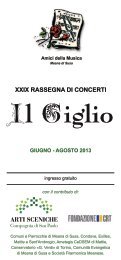
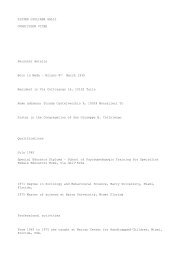
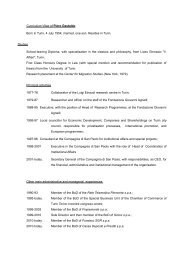
![ArchivioStorico 178 [PDF] - Compagnia di San Paolo](https://img.yumpu.com/47667361/1/185x260/archiviostorico-178-pdf-compagnia-di-san-paolo.jpg?quality=85)

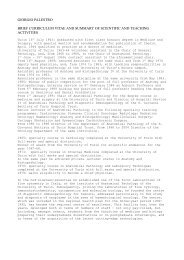
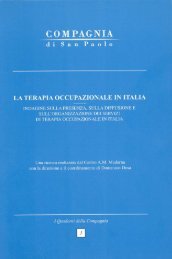
![brochure spazio 768 [PDF] - Compagnia di San Paolo](https://img.yumpu.com/36141511/1/190x255/brochure-spazio-768-pdf-compagnia-di-san-paolo.jpg?quality=85)

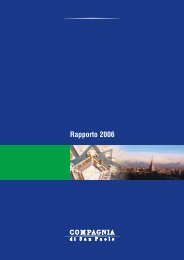
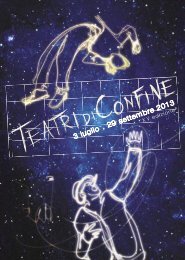

![Rapporto annuale 2008 [PDF] - Compagnia di San Paolo](https://img.yumpu.com/30320485/1/184x260/rapporto-annuale-2008-pdf-compagnia-di-san-paolo.jpg?quality=85)